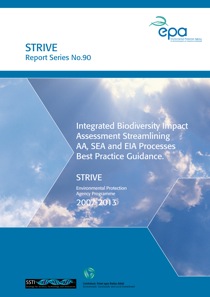Executive Summary - Integrated Biodiversity Impact Assessment, Streamlining AA, SEA and EIA Processes, Best Practice Guidance.
Executive Summary - Ainhoa González, Tamara Hochstrasser, John Fry, Paul Scott,Peter Carvill, Mike Jones, Berna Grist.
Summary: The IBIA guidance aims at informing practitioners, plan/project proponents and consent authorities in integrating the requirements of SEA, EIA and AA in order to streamline biodiversity considerations. IBIA should not be seen as a replacement of existing processes but rather as a framework for coordinating them and for promoting best practice in biodiversity impact assessment.

Integrated Biodiversity Impact Assessment (IBIA) can be defined as a practical and systematic methodological framework for biodiversity impact assessment that integrates SEA requirements with AA for plans and programmes and EIA with AA for projects. Where relevant, IBIA also addresses biodiversityrelevant requirements of the Water Framework Directive (WFD), the Flood Risk Directive (FRD) and the Environmental Liability Directive (ELD). The framework amalgamates assessment processes to enhance the congruence and efficiency of legal, administrative and operational processes. It is envisaged to coordinate efforts; optimise time and resources; reduce/avoid duplication of efforts by improving communication channels and data sharing and enhance cumulative effects assessment. As such this guidance is complementary to other guidance on approaches and specific requirements associated with SEA, EIA and AA. An integration and improvement of procedures is needed to achieve best results for the protection and conservation of biodiversity. The IBIA guidance aims at informing practitioners, plan/project proponents and consent authorities in integrating the requirements of SEA, EIA and AA in order to streamline biodiversity considerations. IBIA should not be seen as a replacement of existing processes but rather as a framework for coordinating them and for promoting best practice in biodiversity impact assessment.
The full technical final report can be downloaded here.
https://www.epa.ie/media/epa-2020/publications/research/STRIVE_90_thumb[1].jpg